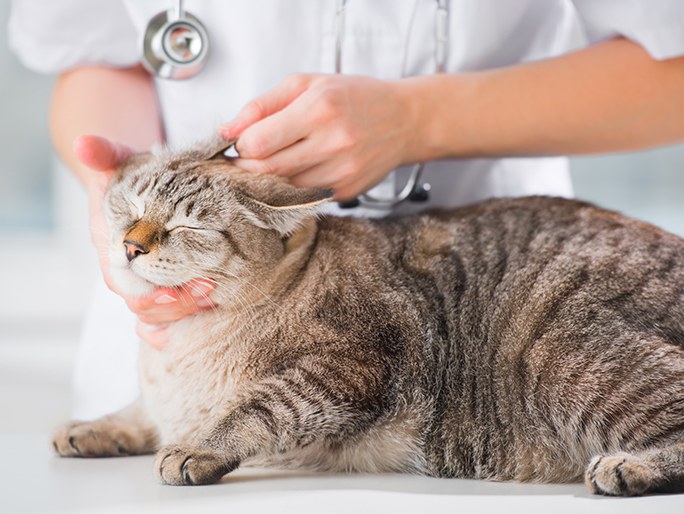ear mites in dogs and cats
These tiny parasites are barely visible to the naked eye, but they can be a big problem for your pet.
Ear mites are small spiderlike parasites that feed on dead skin and ear wax inside your pet’s ear canal. Itchiness from mites can be so extreme that pets can damage themselves and cause ear infections just from scratching.
Ear mite symptoms in cats and dogs
- Black or brown buildup inside ears
- Unusual ear scratching or head shaking
- Rashes, hair loss, or blood clots on or near ears
- Ear sensitivity and pain

Treating ear mites in dogs and cats
- Avoid home “remedies”
- Consult your veterinary team
- Clean ears as directed
- Use prescription ear mite medication

Help prevent ear mites
- Consult your veterinary team
- Regularly check pet ears
- Wash toys and bedding
- Separate infected pets during treatment
All about treating ear mites
Ear mites are a common parasite found in both cats and dogs. The symptoms of ear mites are very similar to those of an ear infection, so please see your veterinary team before you self-diagnose your pet.

Ear mites and ear wax
Ear mites, or Otodectes cynotis, are tiny spiderlike mites that live inside your pet’s ear canal and munch on ear wax and dead skin. Each mite is no bigger than a pinhead, making them difficult to spot with the naked eye.
Mites don’t have a long life cycle, but each female mite makes up for it by laying up to five eggs a day. That means that even a few mites can rapidly grow into a major colony inside your pet’s ear canal.
The itch from ear mites can lead pets to try to scratch or shake them out. It’s not unusual for pets to damage their ears from constant scratching, which can lead to ear infections and long-term hearing loss.
How pets catch ear mites
Ear mites spread among pets through close contact. This includes playing, grooming, sleeping together, and from shared blankets and bedding.
Ear mites are incredibly contagious among pets, including from cats to dogs and from dogs to cats — so if one pet in your household has mites, be prepared to check and treat the rest of your animal family too.
Spot the signs
Adult ear mites only live for a few days. When dead mites build up, they create a telltale greasy or dried-out gunk similar to coffee grounds inside your pet’s ears.
Black, gray, or red-brown goop in ears: While you may never see a live ear mite, you may spot mounds of dead mites in gooey buildup inside pet ears.
Constant ear pawing, scratching, or head shaking: Mites are deeply itchy and uncomfortable, and pets can hurt themselves trying to scratch the itch.
Ear baldness, sores, and bruising: Cats and dogs with mites may scrape their ears and the areas around their ears bald or raw, or give themselves dark blood clots on their ears called aural hematomas.
Ear sensitivity and pain: Pet ears can be tender. Pets with ear mites or ear infections may object to even the most loving touch.
Can humans catch ear mites from dogs or cats?
It’s fairly rare for people to catch ear mites. Try to avoid sleeping with pets who have active ear mite infestations or putting your head and ears anywhere near pet bedding, toys, or furniture where your pet has been.
If you suspect you or another human member of your family has ear mites, please see your doctor.
Why treatment is so important
Ear mites may seem like a minor issue, but there are a number of reasons to check for them regularly and see your veterinary team for treatment.
- Ear mites are deeply uncomfortable for your pet.
- An ear mite infestation can easily cause irritation and swelling inside the ear canal, making it vulnerable to yeast and other bacteria that cause ear infections.
- Scratching at mites can cause bald patches, bleeding, and inflammation that can in turn lead to other ear issues, including infection.
Home remedies for ear mites in dogs and cats
There are no proven home remedies for ear mites. Some internet “cures,” like hydrogen peroxide, can actually hurt your pet.
Plus, even if you’re 100% sure your pet has ear mites, it’s always smart to check with your vet before you put anything — even medications your pet’s been prescribed in the past — into your pet’s ear. Ear mites and ear infection share many of the same symptoms and medicating the wrong issue will not help your pet.
Your veterinary team can run tests, like checking for mites and bacteria under a microscope, and advise you on next steps. These may include cleaning the outside of the ear canal and applying a topical ear mite medication.
When cleaning or medicating pet ears, follow all directions and focus your efforts on the outside of the ear canal. Avoid cotton-tipped swabs and don’t try to clean the inside of the ear canal — these both run the risk of pushing gunk back into the ear, which can backfire on your pet.
Future prevention is key
Your veterinary team can help with advice on preventing ear mites in pets, including regular parasite prevention that can be helpful in battling mites.
You can also help by checking your pet’s ears, cleaning them on a vet-recommended schedule, and washing pet toys and bedding on a regular basis. If your pet has already been diagnosed, keep them separate from their pet playfellows until their treatment is complete.
Mentioned in this article

Does your cat have ear mites?
What to know about ear mites in cats and kittens.
More about ear mites



Need advice on flea control? Ping Pet Chat™!
Whether it's 3 a.m. or 3 p.m., connect with a real veterinary professional for immediate petcare advice. It's included in all Optimum Wellness Plans®!
Log in to start chatting
Save at the Banfield Shop
Our mission is to provide high-quality prescription meds for the pet you love. We believe in safe, effective petcare, so we thoroughly assess every item we carry. We offer discounts on eligible products with your pet’s Optimum Wellness Plan. And you can easily schedule deliveries with our super convenient AutoShip program.
Banfield can help prevent and treat parasites in pets

Regular wellness exams that include a full physical and fecal exam can help keep your furball happy and healthy. Kittens and puppies should start regular appointments when they’re about 6 weeks old, and then come in twice a year once they’re 5 months old. At your visits, we’ll check your little love from nose to tail, discuss age, needs, and lifestyle, and recommend trusted prevention medication to help fight off nasty critters that might feed on your pet.
Even if your pet is on a regular preventive for fleas, ticks, worms, mange, and other bugs, please make an appointment as soon as possible if you spot potential symptoms. Sooner is always better in helping to prevent a big infestation for your furry friend.
 Mites and mange
Mites and mange Podcast - Not Just Fluff
Podcast - Not Just Fluff



